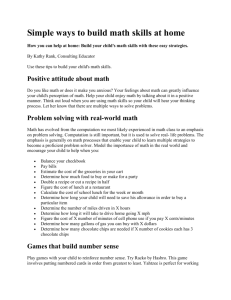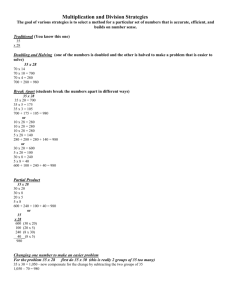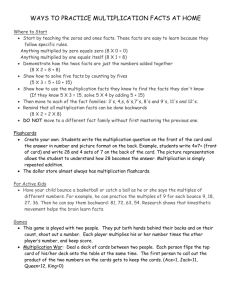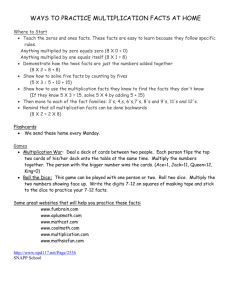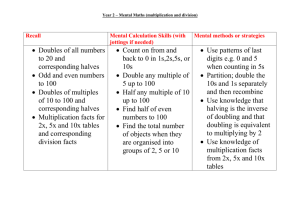MD - Stage 2 - Plan 10 - Glenmore Park Learning Alliance
advertisement
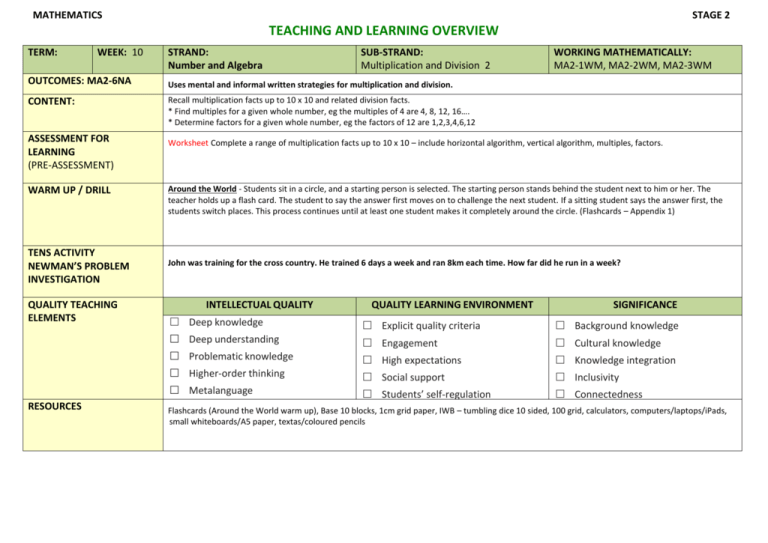
MATHEMATICS STAGE 2 TEACHING AND LEARNING OVERVIEW TERM: WEEK: 10 OUTCOMES: MA2-6NA CONTENT: ASSESSMENT FOR LEARNING (PRE-ASSESSMENT) WARM UP / DRILL TENS ACTIVITY NEWMAN’S PROBLEM INVESTIGATION QUALITY TEACHING ELEMENTS RESOURCES STRAND: Number and Algebra SUB-STRAND: Multiplication and Division 2 WORKING MATHEMATICALLY: MA2-1WM, MA2-2WM, MA2-3WM Uses mental and informal written strategies for multiplication and division. Recall multiplication facts up to 10 x 10 and related division facts. * Find multiples for a given whole number, eg the multiples of 4 are 4, 8, 12, 16…. * Determine factors for a given whole number, eg the factors of 12 are 1,2,3,4,6,12 Worksheet Complete a range of multiplication facts up to 10 x 10 – include horizontal algorithm, vertical algorithm, multiples, factors. Around the World - Students sit in a circle, and a starting person is selected. The starting person stands behind the student next to him or her. The teacher holds up a flash card. The student to say the answer first moves on to challenge the next student. If a sitting student says the answer first, the students switch places. This process continues until at least one student makes it completely around the circle. (Flashcards – Appendix 1) John was training for the cross country. He trained 6 days a week and ran 8km each time. How far did he run in a week? INTELLECTUAL QUALITY QUALITY LEARNING ENVIRONMENT SIGNIFICANCE Deep knowledge Explicit quality criteria Background knowledge Deep understanding Engagement Cultural knowledge Problematic knowledge High expectations Knowledge integration Higher-order thinking Social support Inclusivity Metalanguage Substantive communication Students’ self-regulation Connectedness Flashcards (Around the World warm up), Base 10 blocks, grid paper, IWB – tumbling dice 10 sided, 100 calculators, computers/laptops/iPads, 1cm Student direction grid, Narrative small whiteboards/A5 paper, textas/coloured pencils WHOLE CLASS INSTRUCTION MODELLED ACTIVITIES Explicitly teach IWB Tumbling Dice Game Using your Smartboard, go into the notebook and, from the gallery, paste on two tumbling dice (10 sided). Students can play a challenge where 1 student tumbles the dice and another has to give the answer to the product of the numbers…OR…play Tables Baseball GUIDED & INDEPENDENT ACTIVITIES LEARNING SEQUENCE Remediation S1 or Early S2 LEARNING SEQUENCE S2 WC Multiples: Multiple Clapping The class stands. Say the number 4 and have students take turns around the class saying consecutive numbers and clapping on the multiples until they reach (4x10) 40. Students are out if they clap on a wrong number or fail to clap on a multiple. When only a few students are left standing, increase the speed. Factors and Multiples Game This is a game for two players. Players require a 100 grid or may play the game online at: http://nrich.maths.org/5468 The first player chooses a positive even number that is less than 50, and crosses it out on the grid. The second player chooses a number to cross out. The number must be a factor or multiple of the first number. Students may use a calculator to confirm if the number is a factor or multiple, or consult a multiplication grid. Players continue to take it in turns to cross out numbers, at each stage choosing a number that is a factor or multiple of the number just crossed out by the other player. WC Factors: Whole class build rectangles using 24 cubes to make rectangular patterns Record the number of cubes on each side. Explain that the numbers on the side are the factors of 24. Represent all possible rectangles on grid paper. List the factors of 24:1,2,3,4,6,8,12,24 Choose another number – 12. Repeat activity. Metalanguage: groups of, rows of, lots of, totals, equals, makes, is the same as, factor, multiple, width, product, times, multiply, multiplied by, multiplication, multiplication facts, tens, ones, double Arrays Students use concrete materials to create arrays for various multiplication number sentences. Create a label to match each array. Whole class instruction and modelled activities Worksheet: Students complete activities which require them to identify factors and multiples. Multiplication Bingo Give each pupil an A5 sheet of paper or a whiteboard. Find out how many times tables they have learnt and decide from there. Ask pupils to draw a square grid, divide it into nine parts and write the answers from two different times tables, any between two and 10, into each square. You can help by giving them some examples orally. Call out a number sentence such as “six times six”. Pupils with 36 in their grid cross out the number. The first person to cross out all the numbers says “Bingo”. Then play it again. Investigation Factors Students independently, or in groups, construct rectangles with cubes to find the factors of: 8, 10, 12, 15, 20, 30, 36. Copy onto 1 cm grid paper and display in the class. Bubble Multiples Students pop the bubbles which are multiples of the given number. They may race against the clock or play against an opponent, and alter the difficulty with the speed, time limit and multiple ranges. http://www.teachitmaths.co.uk/shared/free/InteractiveEssentials/Shared/free_sample_maths.html Assessment: Quick Flash II - Multiplication Math Practice In the opening screen, students can choose their starting level. After they begin, the program will progress through all of the multiplication facts in flash card style. With each correct answer, a green block will be stacked next to the flash card. Incorrect answers receive a red block. If you have your students in the computer lab, you can easily walk around and see student progress. The green and red boxes will tell you the problem multiplication facts. http://www.multiplication.com/games/play/quick-flash-ii LEARNING SEQUENCE Extension Late S2 or Early S3 EVALUATION & REFLECTION Extension Factor Trees – Show students how to create a factor tree. They can create their own in their books or display in the classroom. Were the students engaged in learning? Were resources appropriate/easily available? Did group work allow for differentiation? Were students able to reflect on their learning?
